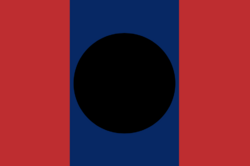Huangul
Huangul | |
|---|---|
|
Flag | |
Anthem: '' | |
| 300px |
Huangul is a nation on the continent of Tanglao
Contents
- 1 History
- 1.1 Gul Kheng Era (1105-1126)
- 1.2 First Warring Era (1126-1154)
- 1.3 Sonaka Government Era (1171-1497)
- 1.4 Fuksha-Huangul War (1497-1498)
- 1.5 War of Chikara (1498-1506)
- 1.6 Return to Warring Factions (1510-1533)
- 1.7 Kim Yuk & the Isolationist Era (1533-1776)
- 1.8 Empire of Huangul (1776-1947)
- 1.9 Sovereign People's Republic of Huangul (1947)
- 2 Economy
History
Gul Kheng Era (1105-1126)
Dominated by kingdoms of Huangul, Chaokoong, Chao-Do, and Jungwei. After Kheng's dominance ended, Huangul split into 14 warring kingdoms.
First Warring Era (1126-1154)
Jungwei Kingdom, aligned with Xinglao, overthrows Chaokoong and Chao-Do in 1130. In 1133, Jungwei's weak government was overthrown by Chaokoong. ===Onari Government Era (1154-1171)
Sonaka Government Era (1171-1497)
Utana independence (1349)
Fuksha mercenary rule (1356-1497)
Utana-Xinglao Wars (1365-1481)
First Utana Invasion of Xinglao (1365)
Second Utana Invasion of Xinglao (1430)
Third Utana Invasion of Xinglao (1438-1445)
Xinglao Annexation of Utanbar (1481)
Fuksha-Huangul War (1497-1498)
War of Chikara (1498-1506)
Return to Warring Factions (1510-1533)
Kim Yuk & the Isolationist Era (1533-1776)
Dissolution of the Sonaka government
Invasion of Xinglao
Invasion of Chaokoong
Second Invasion of Xinglao
Empire of Huangul (1776-1947)
War for Chaokoong (1868-1921)
Chaokoong remained a strong state within Huangul, opposing the main government of Huangul since Chaokoong-led government fell in 1154.
The unification of Huangul in 1533 left three major states in Huangul: Huangul, Chaokoong, and Sonaka. During this period, Kim Yuk's government felt Chaokoong's leadership was far too defiant to maintain the unification of the Empire. Yuk launched an invasion in XXXX to absorb the Chaokoong state within the capital state of Huangul. Chaokoong lost most of its freedoms as an independent state of the nation.
In 1561, the Sonaka state was dissolved and the Empire of Huangul was two states: Huangul and Chaokoong.
In 1852, Huangul sought to reorganize the government. The Hunagul army launched a full scale conquest of Chaokoong's government and succeeded.
In 1857, citizens that identified with Chaokoong heritage launched a large-scale protest movement and were met with one of the bloodiest massacres in Huangul history. This further sparked a deep-seated independence movement within Chaokoong.
The local government of Chaokoong divided between East and West, the East fighitng for independence and the West striving to remain loyal to the Huangul government.
In 1868, East Chaokoong formally declared its independence. In the late 19th century, East Chaokoong began adopting the ideals of Migamoralism to fuel the populist movement for independence. By 1890, the East Chaokoong movement was recognized internationally as a Migamoralist revolution.
In 1890, Huangul granted semi-autonomy to East Chaokoong, believing the strain on resources to control the state was not worth it.
East Chaokoong's government in 1890 quickly morphed into a corrupt and authoritarian dictatorship, persecuting ethnic groups that did not align with Chaokoong nor aligned with the Migamoralist movement. The government of Huangul orchestrated a clandestine assassination of dictator, installing a more "well behaved" leader within East Chaokoong. The new leader was little improvement from the last, contuining to govern East Chaokoong under authoritarian rule.
Between 1899 and 1901, Huangul launched a war against the East Chaokoong Migamoralist "freedom fighters". The war garnered international support against the spread of Migamoralism. The June Democratic struggle in Tanglao ignited the guerilla warfare of the freedom fighters, proving to be a challenge to be put down by Huangul.
The war between Huangul and East Chaokoong reached stalemate in 1902, with Huangul effectively tightening its grip on the state, and the EC's movement dwindling.
In 1917, the United Laophung Republic within Xinglao fueled traction to EC by proving to be a strong ally.
In 1921, the United Laophung Republic launched an invasion of East Chaokoong and was met with strong opposition from the government of Huangul. Following the failed invasion, East Chaokoong's independence movement crumbled and became fully enveloped within Huangul. By 1921, Huangul's government had already adopted Migamoralist policies within its government.
Sovereign People's Republic of Huangul (1947)
The new government of Huangul in 1947 was heavily influenced by several decades of Migamoralism within its government, however, never became part of the majority government. By 1973, Wesvilism won out for businesses and they adopted migamoralist social policies.
Economy
Shingawen Corporation, oil venture with PetroGow.
